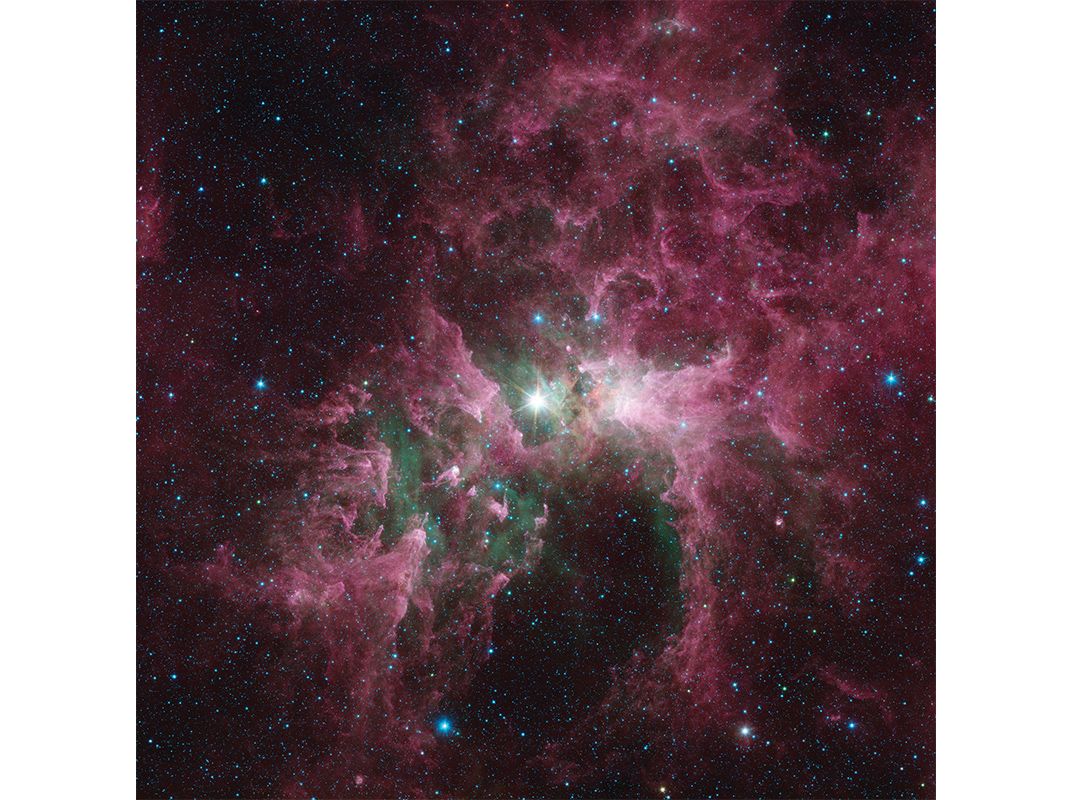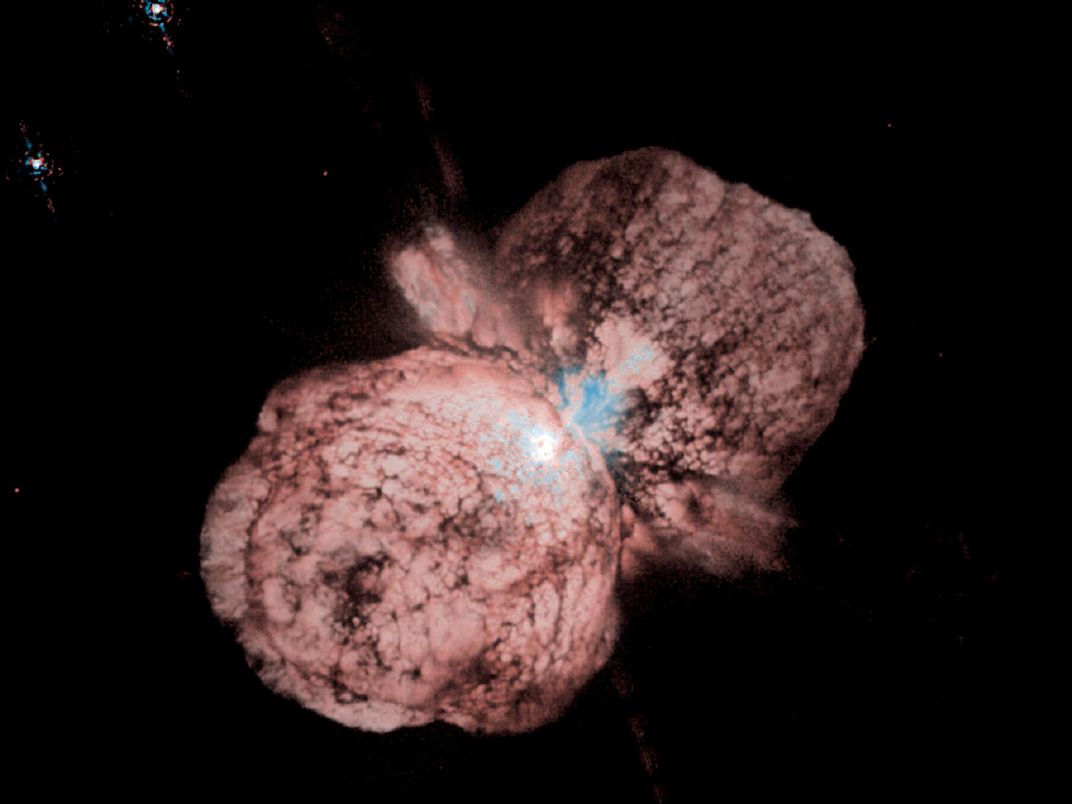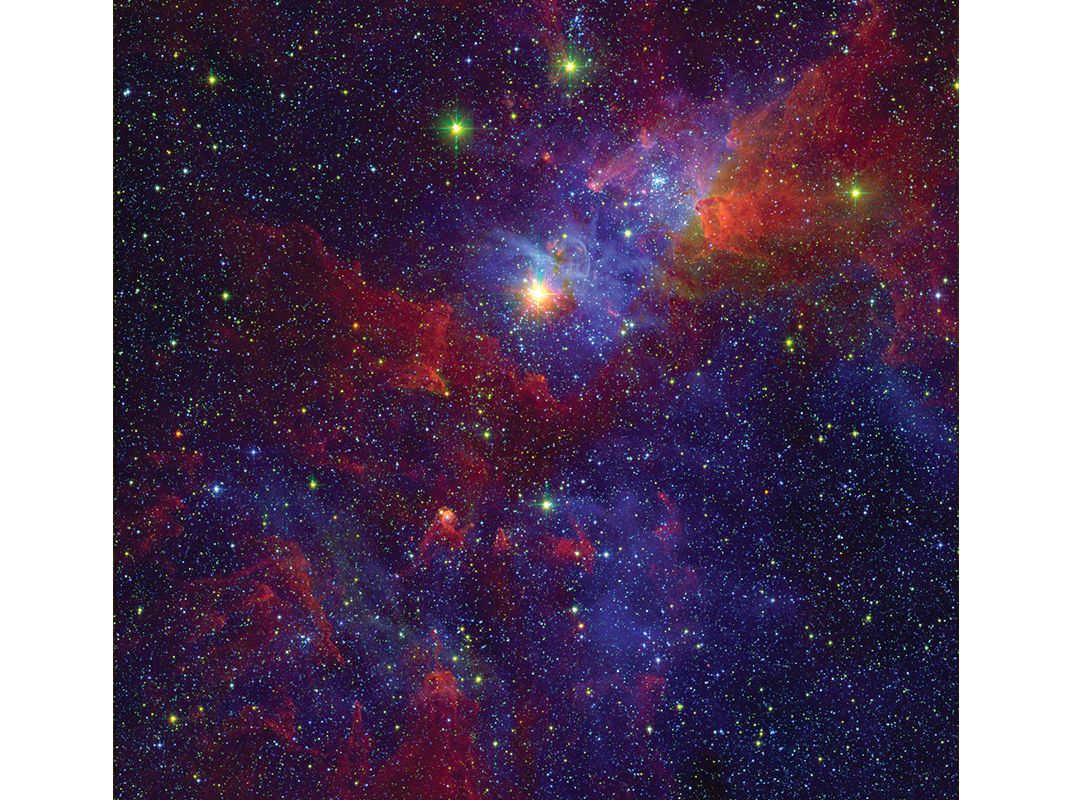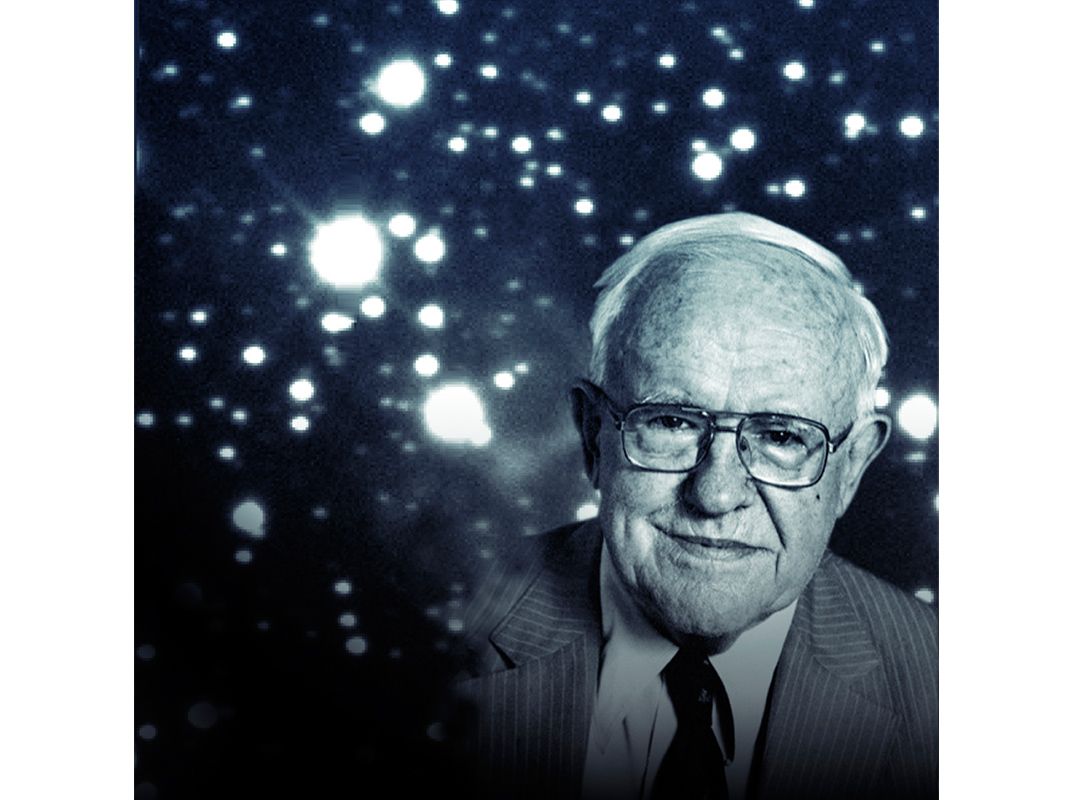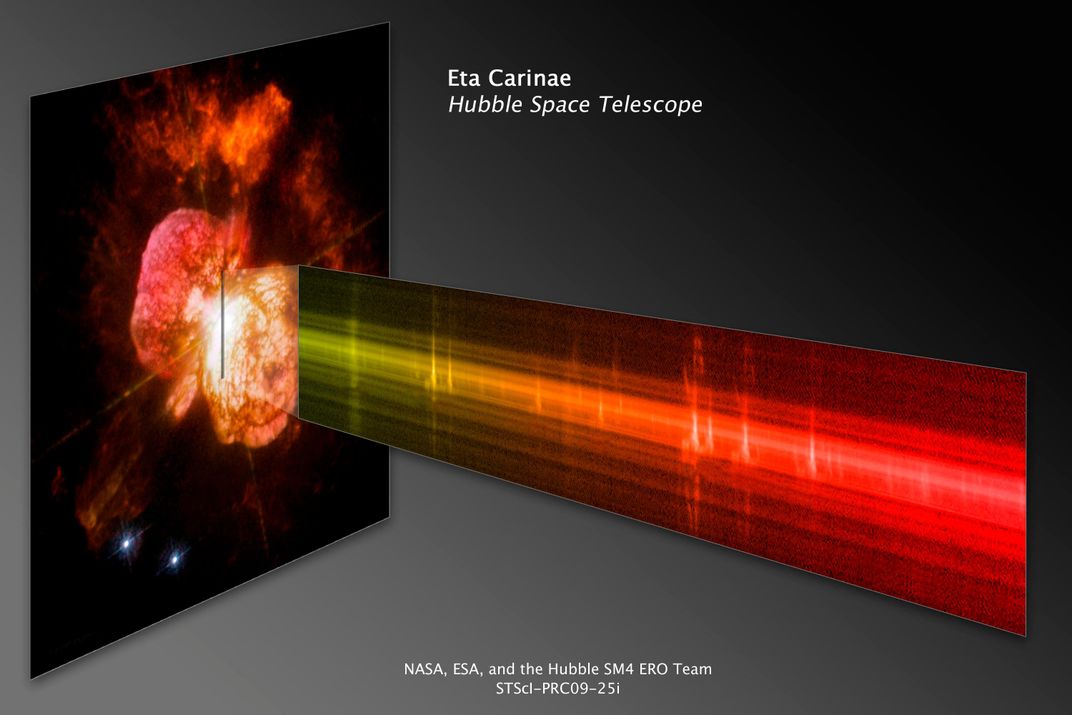Mystery Star
For well over a century, astronomers have been enchanted by the peculiar, vast, and violent Eta Carinae.
/https://tf-cmsv2-smithsonianmag-media.s3.amazonaws.com/filer/3b/35/3b356f69-6ede-402b-8e13-823bb6cd8a4f/02o_dj2016_carinanebulaandbrightstar_live.jpg)
Astronomers are drawn to things that change: planets moving among the stars, stars moving among themselves, stars that change in color and brightness. Over the centuries, some of them have fallen in love with a single star because of how it changes, observing it for decades. The sixth-generation astronomer Otto Struve keenly followed the star Beta Lyrae, observing it for years as it dimmed or brightened, even when he was a Russian artillery officer, serving night duty on the Turkish front during the first world war. For his entire career, Struve wondered about that star, publishing 29 papers about it and making it, in the words of a contemporary, his “personal friend.”
Other stars have reached past a single astronomer’s obsession to fascinate scientists across time. In the Perseus constellation, the bright star in the head of Medusa, called Algol from the Arabic Ra’s al Ghul (the Blinking Demon) and immortalized by Homer in The Iliad, has appeared in many thousands of studies, teasing astronomers for hundreds of years. Carried by Perseus through the night sky, once every three days it winks for about 10 hours. Like Beta Lyrae, Algol is a binary star, a system of two stars that tug at each other, or that cross in front of each other, or, most provocatively, that can rip huge masses of gas off each other, causing all sorts of violent consequences, like the enormous explosions called novae. These are among the most dramatic changes astronomers hope to witness.
Novae can briefly outshine regular stars by millions of times; supernovae by many billions; hypernovae by orders of magnitude greater. The only star that could possibly be more interesting to astronomers than a super- or hypernova is a star that is about to become one. Finding an almost-nova would give observers the chance to see the whole show, from the buildup to the initial explosion to the years of subsequent expansion and turmoil. In fact, there is one star that astronomers have been watching for years, predicting it will blow up soon—Eta Carinae, one of the brightest, most massive, and most puzzling stars in the Milky Way.
Eta Carinae, about 8,000 light-years from Earth, was classified as a variable star in the 19th century, when astronomers observed it slowly changing in brightness. But from 1841 to 1843, it brightened violently, attracting more and more attention as it became almost as bright as the brightest star in the sky, Sirius. By 1868, it had faded so much it couldn’t be seen by the naked eye. In the 1920s, astronomers analyzed its spectrum and found bright emission lines, indicating expanding clouds of hot gases reminiscent of novae in their early stages. But the spectra were confusing, and there were hints that this was not one star, but two.
High-powered visual observations made in the late 1940s with a 61-inch reflector at Córdoba, Argentina, revealed the star was surrounded by a complex physical structure. Ernesto Gaviola, then the director of the Astronomical Observatory of Córdoba, called the structure a “homunculus,” or “little man,” with “its head pointing northwest, legs opposite and arms folded over a fat body….” This tiny cloud was believed to be the debris from the violent brightening in the 1840s, but was the brightening evidence of a supernova? Puzzled by its erratic behavior, astronomers wondered if Eta Carinae is a nova in slow motion, or even a supernova impostor, since the progenitor star has survived.
Astronomers try to make sense of structures in the universe by classifying them—by location, brightness and color, mass, spectrum, multiplicity, and behavior. Though Eta Carinae defies classification in some of these categories, it is similar to a group of very massive, hot, blue stars—with masses 20 times that of our sun. Massive stars of the blue spectral classes are typically young stars because they have very short lifetimes, in astronomical terms. The most massive of these are unstable from the start. What makes Eta Carinae so complex is that it is a double-star system, and both stars are unstable. One is a supergiant in mass; the other, a subgiant.
The Spectrum of a Gem
I first got to know Eta Carinae because of one of my professors at UCLA, Lawrence H. Aller, an influential astronomer who proclaimed the star “the gem of the southern skies.” Aller was frustrated by an accident of geography: He lived and taught in the northern hemisphere, and many of the objects he wanted to study could be seen only south of the equator. “Why did God put astronomers in the north, and the best things to observe in the south?” he often grumbled. In 1963, Aller wrote a popular essay titled “Why Go South?” for the Astronomical Society of the Pacific, one of the largest mix of amateurs and professionals in the world. Starting in 1960, he had spent as much observing time as he could at Mount Stromlo, outside Canberra, Australia, and in the essay he wrote about the wonders he was able to see from there: the Magellanic Clouds, two small satellite galaxies of the Milky Way; the spectacular 30 Doradus complex, with dozens of hot, blue stars; and Eta Carinae, which he called “one of the most bizarre stars in the sky.” Each time he returned to UCLA from Mount Stromlo, he very tenderly handed his spectroscopic plates over to his students, directing us to turn the recorded spectra into astronomical data. Eta Carinae, he told us, is one of the most massive stars known today, but instead of being a young star in the process of forming, it is a mature star on a track toward self-destruction.
I started working for Aller in 1962, as a sophomore astronomy major. Somehow he thought I knew what I was doing. Grad students and postdocs helped me learn how to use a photoelectric microdensitometer, an instrument that records minute changes in light transmission properties over the length of a photographic plate. Aller would hand me a box of spectroscopic plates, taken of different stars from a variety of telescopes, and I’d take the delicate glass plate negative and lay it on the glass surface of the microdensitometer. These were negative images; areas that were dark indicated the portions of the spectrum that were bright, and the brightness indicated the emission of energy. Areas that were transparent indicated the portions of the spectrum that were dark, and the darkness indicated the absorption of energy. Each action—emission and absorption—arises from very different physical circumstances and chemical interactions, so analyzing the spectrum of a gaseous body—a star, say—reveals its structure, composition, and motion. All that from a point of light!
While I was working with the spectra, Aller would often pop in without warning. “Well, Mr. DeVorkin, how are the numbers?” he’d say. To this day, I don’t know what he meant. He seemed satisfied when I told him how many plates I had scanned, after aligning the spectra with the densitometer’s traveling platen. The electrical signal from the microdensitometer fed a chart recorder that printed out the profile of the spectrum.
Aller and his students and colleagues published more than a dozen papers in the 1960s about Eta Carinae, mapping its complex spectrum and isolating the spectrum of the star from that of the turbulent nebular structure around it. Mapping like this was essential to unravel the physical processes at play in the system. When I finally saw the real Eta Carinae in the dark starlit sky, during a 2011 visit to Mount Stromlo, I thought back on all the work my colleagues had done at UCLA to analyze the spectra obtained from this magnificent object.
The Next Eruption
Emeritus astronomer Ted Gull has festooned the walls of his office at NASA’s Goddard Space Flight Center in Greenbelt, Maryland, with printouts of the spectral signatures of Eta Carinae’s homunculus and its surroundings, observed with the Hubble Space Telescope’s imaging spectrograph. Since 1981, Gull, one of the most prolific and dogged explorers of Eta, has tracked the star in the visible, ultraviolet, infrared, radio, and X-ray ranges of the spectrum and authored or co-authored well over 200 papers on it. Fascinated, like Aller , with the constantly changing structure of the nebula, Gull and his staff recently developed and printed a 3D model to help illustrate the complex, evolving structure.
In the early 1980s, Gull joined forces with Nolan Walborn and Kris Davidson, who had been pondering Eta’s behavior for a decade. The three astronomers observed Eta Carinae with a variety of telescopes, including the International Ultraviolet Explorer, operated jointly by Goddard and the European Space Agency, and the four-meter (13-foot) reflector at the Cerro Tololo Inter-American Observatory near La Serena, Chile. They discovered that vast clouds of gas around the homunculus had in fact been ejected from the star before 1840. The clouds’ nebular spectra revealed that the central star’s outer layers were hugely turbulent and anomalously rich in nitrogen and oxygen, as well as in magnesium, iron, silicon, sulfur, and calcium—elements formed by nuclear burning deep inside the star.
As is the case with any erratic variable star, one of the greatest rewards is to be able to predict its behavior: When will it brighten or dim? When will it finally explode? In the 1970s, astronomers found the evidence suggesting that Eta Carinae is a double star, but only with multi-spectral monitoring in the mid-1990s could the orbits be plotted. Today we know that there are two stars—one that is 90 times the mass of the sun and one suspected to be 30 times as massive—and that they complete an orbit around each other once every five and a half years. During this period, they draw as far apart as the sun and Neptune and as close together as the sun and Mars.
Now the question for astronomers has become: What happens when the two stars are at their closest, a point known as periastron? These very massive stars, expanding and contracting, are far less stable than our sun. As they move around each other, their erratic variations are not necessarily in sync with their orbits. But there must come a time when, as the two stars approach periastron, one of the erratic pulsators is puffed up to the point where chunks of its outer atmosphere are tidally ripped away by the other star, causing massive collisions and disruptions. Observations with the Hubble are essential to achieve the high spatial resolution required to distinguish what is happening between the two stars, the surrounding homunculus, and the general maelstrom of ejecta that makes up the bipolar plumes of Eta Carinae.
The Hubble has been used many hundreds of times to examine Eta Carinae and its surrounding nebula. The Hubble, the Spitzer infrared telescope, and other observatories in space and on the ground are tracking light echoes from the 1840s that blast farther and farther out into the nebula. Hubble’s imaging spectrograph is also tracking waves of superheated gas and dust from the interacting stars. When these waves collide in the innermost regions of the homunculus, somewhere between the two stars, they produce X-ray radiation, which has been monitored by powerful X-ray telescopes like the Chandra X-Ray Observatory and instruments on NASA’s Swift space telescope. The X-ray flux disappears once every five and a half years, confirming that Eta is eclipsing the region where X-rays are produced.
In June 2003, astronomers excitedly anticipated the next eclipse. Using NASA’s Far Ultraviolet Spectroscopic Explorer to observe the star system, a team of astronomers including Ted Gull found that just before the X-rays disappeared, radiation in the far ultraviolet end of the spectrum also disappeared. The team interpreted the disappearance to mean that the companion is far hotter than Eta itself, producing extreme ultraviolet radiation that disappears when Eta moves between it and the observatories in Earth orbit.
Using data collected during the last three periastrons, in 2003, 2009, and 2014, Gull’s team at Goddard created a computer simulation of the interaction of the stellar winds and printed a 3D model of the nebula to help analyze its complex, evolving structure. The Goddard simulations have recently shown that when the stars are closest, fingers of turbulent gas point from the region where the two stellar shock fronts are colliding. These fingers may well be harbingers of greater instabilities. With these three-dimensional, numerical models of the star system, the Goddard team can follow the interactions of the winds from the two stars in the hopes of predicting, as far as possible into the future, when the entire system will erupt again as it did in the 19th century, or blow up completely as a real supernova or even hypernova—proof that it is not the impostor it had been labeled.
Will it happen at the next periastron, in early 2020? Any telescope capable of watching will have astronomers clamoring for observation time. Together, someday, all these telescopes may produce a portrait of the dynamics of Lawrence Aller’s bizarre gem and a prediction of when Eta will become for a moment the brightest star in our night sky.
